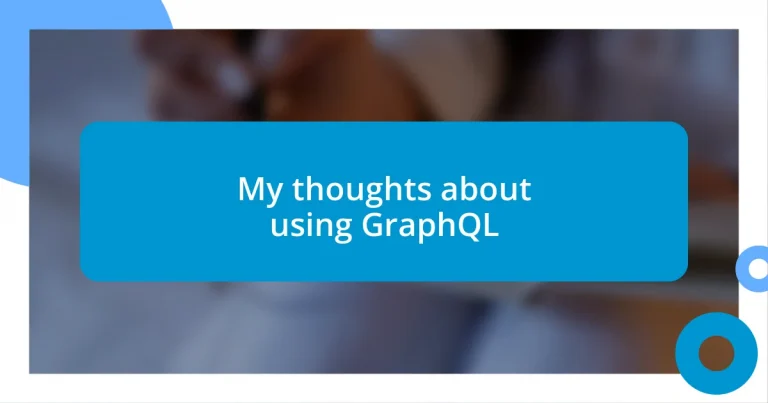Key takeaways:
- GraphQL enhances data retrieval by allowing clients to request only necessary data through a strong typing system and a single API endpoint, reducing runtime errors and complexity.
- The framework significantly improves efficiency in data interactions, such as consolidating multiple API calls into one request, which is especially beneficial in complex applications and mobile services.
- Implementing GraphQL presents challenges like query complexity and monitoring; however, best practices such as thoughtful schema design and robust documentation can greatly simplify the development process.
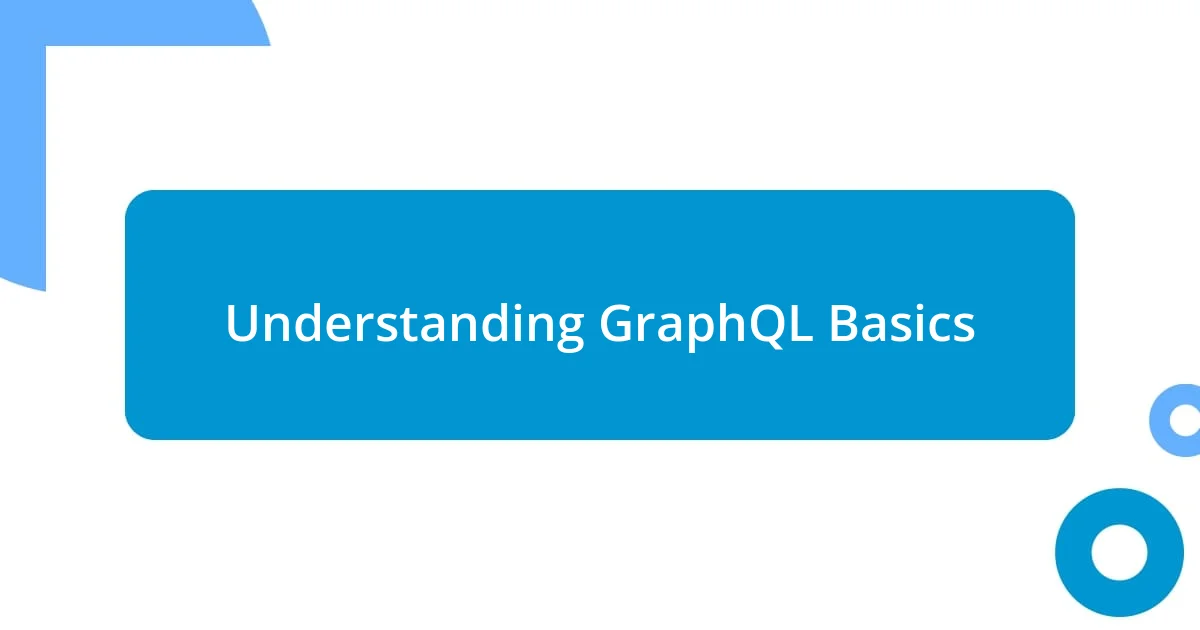
Understanding GraphQL Basics
At its core, GraphQL is a query language for APIs that allows clients to request only the data they need. I remember the first time I encountered it; I was initially overwhelmed by its flexibility but quickly grew to appreciate how it simplifies data retrieval. Doesn’t it feel empowering to fetch exactly what you want without dealing with excessive data being tossed your way?
One critical aspect of GraphQL is its strong typing system, which ensures that responses adhere to a strict schema. This aspect has dramatically reduced runtime errors for me, almost like having a safety net. Have you ever spent hours debugging vague errors? With GraphQL’s introspective nature, I now find it easier to understand exactly what data structures I’m working with.
Another fundamental concept is the idea of a single endpoint for your API. This shift fundamentally changed how I think about data access. Could you imagine the simplicity of not having to juggle multiple URLs for different resources? It’s quite liberating and significantly reduces the complexity of making network requests, making development a much smoother process.
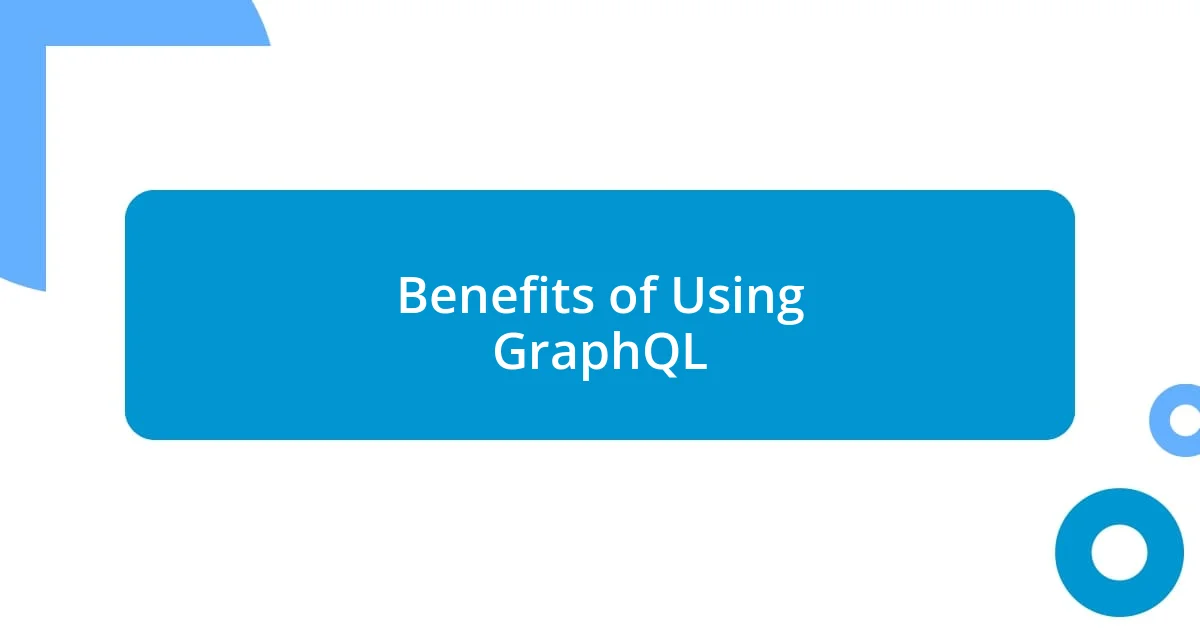
Benefits of Using GraphQL
The advantages of using GraphQL are numerous and can significantly enhance your development experience. One of the key benefits I’ve observed is its ability to reduce the number of network requests. I recall a project where I was fetching user data along with their related posts and comments; traditionally, this required multiple API calls. With GraphQL, I was able to gather all this information in a single request, which not only saved time but also improved the overall user experience.
- Efficient Data Retrieval: Fetch only the data you need, minimizing over-fetching.
- Single Endpoint: Simplifies API structure and makes network management easier.
- Strong Typing: Reduces the likelihood of runtime errors by adhering to a strict schema.
- Real-Time Capabilities: Subscriptions allow you to get real-time updates, enhancing interactivity.
- Documentation: GraphQL’s introspective nature provides self-documenting APIs, making it easier for developers to understand the available data.
Moreover, the experience of working with GraphQL has been incredibly rewarding for my team. I remember implementing a feature where we provided a dynamic search capability in our application. Rather than sending multiple queries and handling the various responses, we crafted one flexible query that adapted based on user input. The sense of efficiency and control I felt was tangible; it allowed us to focus on higher-level features rather than getting bogged down in the minutiae of backend queries. It truly showcases how GraphQL encourages a more thoughtful approach to API development.
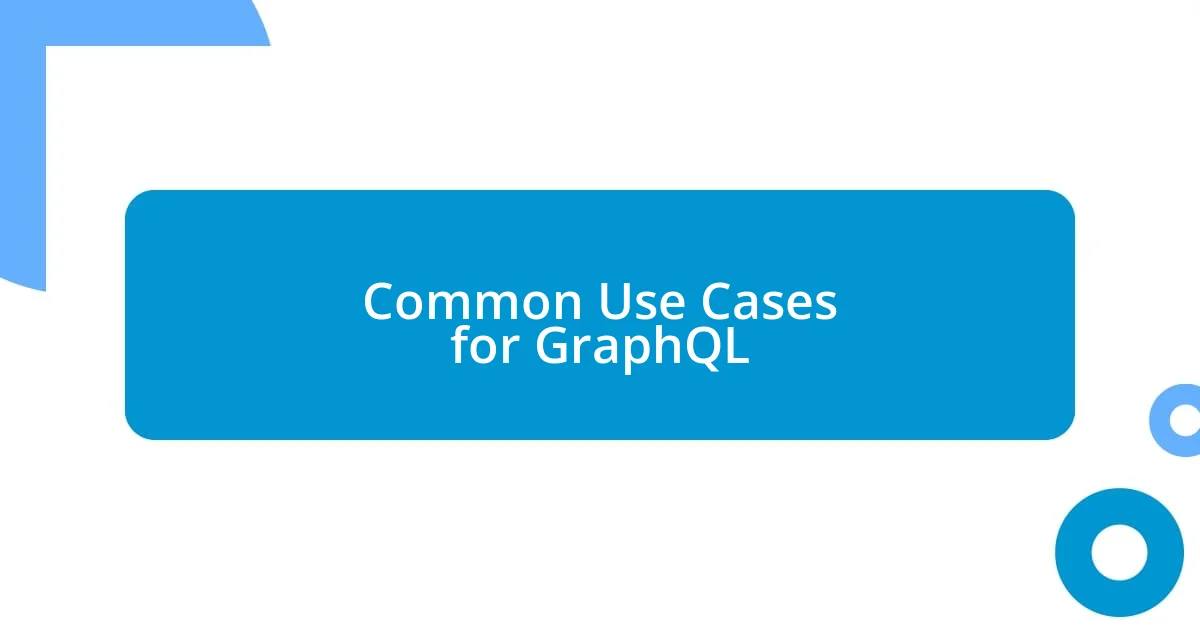
Common Use Cases for GraphQL
When it comes to real-world applications, GraphQL shines in scenarios requiring complex data interactions. Imagine working on an e-commerce platform where you need product details along with user reviews, inventory levels, and similar products. Instead of cluttering the network layer with numerous requests, I crafted a single query that pulled all this data together seamlessly. This streamlined my workflow and made the development process not just efficient but truly enjoyable.
Another common use case I’ve encountered is in mobile applications. The need for efficient data loading is paramount on mobile devices, as each API call can affect performance and user experience. I recall developing a travel app where users could query their destinations and activities. Thanks to GraphQL, I could design a single request that allowed users to get all necessary information quickly, which significantly improved app responsiveness. The sense of accomplishment in creating a smooth experience for users is something I value deeply.
Beyond traditional applications, I find that GraphQL is invaluable in creating microservices architecture. In one project, I remembered needing to integrate various services like authentication, inventory management, and user profiles. Instead of having to manage multiple endpoints, I created a unified API interface with GraphQL that consolidated interactions. This approach didn’t just simplify the structure; it felt like turning a complicated puzzle into a coherent picture. It’s fascinating how such a framework can transform complexity into clarity.
| Use Case | Description |
|---|---|
| Complex Data Retrieval | Ideal for applications needing to fetch interconnected data efficiently, like e-commerce platforms. |
| Mobile Applications | Enhances performance by reducing the number of API calls, crucial for optimal user experience on mobile. |
| Microservices Integration | Streamlines interactions between multiple microservices, creating a cohesive API experience. |
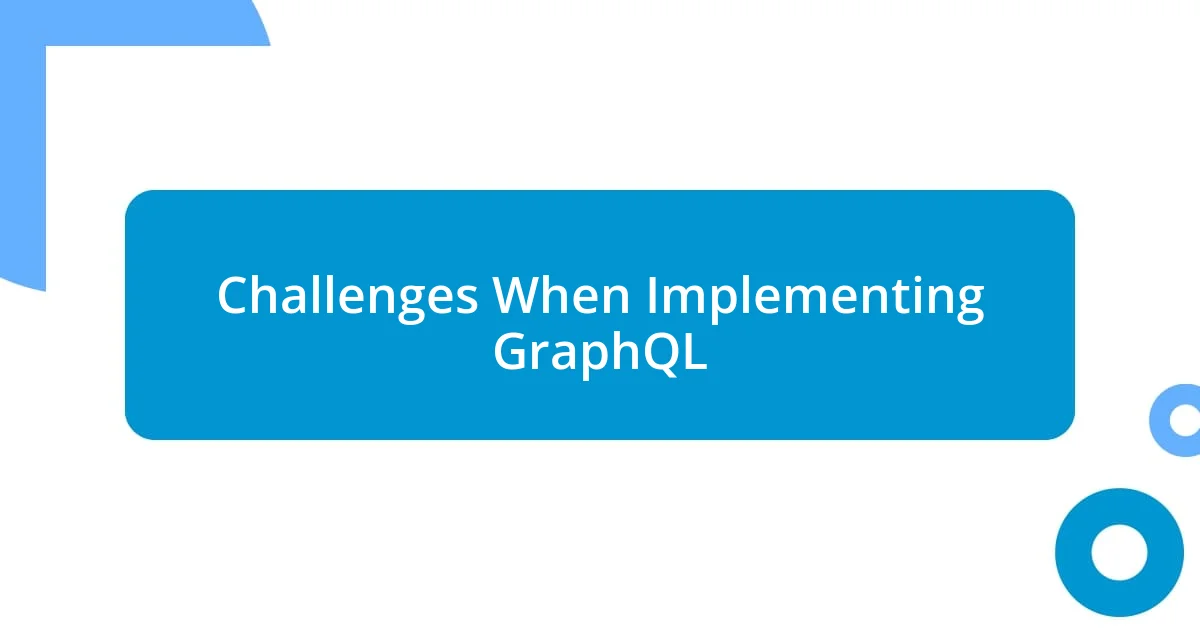
Challenges When Implementing GraphQL
Implementing GraphQL can present its own set of challenges, something I’ve encountered firsthand. One significant hurdle is the learning curve associated with this technology. Initially, I felt overwhelmed by the new concepts, like schemas and queries. It was a bit like trying to learn a new language—exciting yet daunting. Have you ever faced that moment when you’re so intrigued by a tool but find it hard to see the path forward? As I pushed through that initial confusion and began to understand its nuances, the rewards became evident.
Another challenge I noticed is query complexity. In one project, I aimed to create a highly dynamic interface with multiple optional fields. It quickly got out of hand, making it tricky to optimize queries. I found myself contemplating how to balance flexibility without overwhelming backend performance. It was a delicate dance, and I recognized the importance of crafting queries that were both powerful and maintainable. Have you ever struggled to keep your codebase clean while incorporating new features? It certainly can be a juggling act.
Lastly, monitoring and caching require careful attention. When I first started with GraphQL, I underestimated the importance of tracking performance and managing data caching. It was frustrating to see slowdowns when queries were made too complex, and I had to rethink my strategies for efficiently managing data flow. This experience taught me that proper tooling and understanding of performance metrics are essential for a smooth implementation. Have you ever had a moment where oversight of a small detail led to bigger issues down the line? It’s a lesson that almost every developer learns, and I certainly did through grappling with GraphQL’s intricate demand on resources.
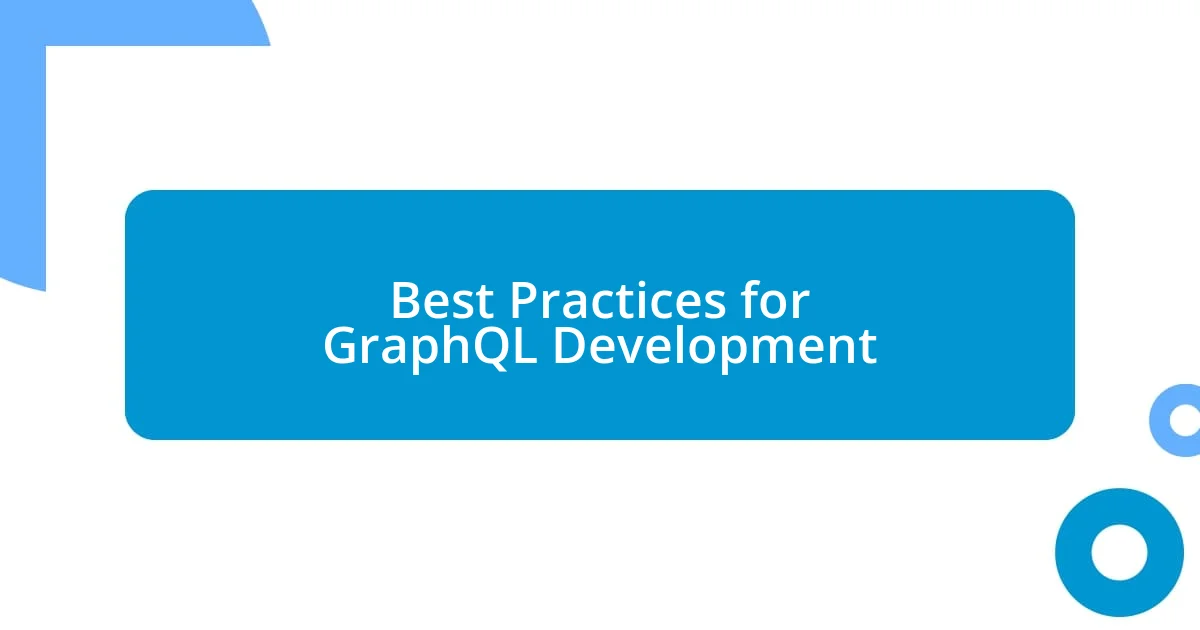
Best Practices for GraphQL Development
When developing with GraphQL, one of the best practices is to design your schema thoughtfully. I remember a project where my team rushed through schema design, but we quickly learned that a well-structured schema becomes the backbone of your API. By defining clear types and relationships, I found that our queries became far more intuitive, making it easier for frontend developers to work with the data. Have you ever experienced a situation where the initial setup made later tasks so much simpler? It’s amazing how foundational choices can save so much time in the long run.
Another crucial best practice involves batching and caching requests. I recall a time when we dealt with an application that faced performance issues under load. By implementing batching for complex queries and setting proper caching strategies, we watched the response times improve significantly. That moment of relief when everything started running smoothly was invigorating. Have you felt that thrill when a performance bottleneck is resolved? It’s like seeing a heavy weight lifted off your shoulders, and batching plays a key role in that relief.
Lastly, maintaining robust documentation is often underrated. In my early days with GraphQL, I neglected this aspect and watched as team members struggled to understand the API’s nuances. It was a learning moment for me! I realized that clear and comprehensive documentation not only helps current team members but also aids onboarding new developers. Have you ever wished you had better documentation while diving into a complex project? Trust me, investing time in documentation pays off immensely, fostering a better collaborative environment and a more productive workflow.
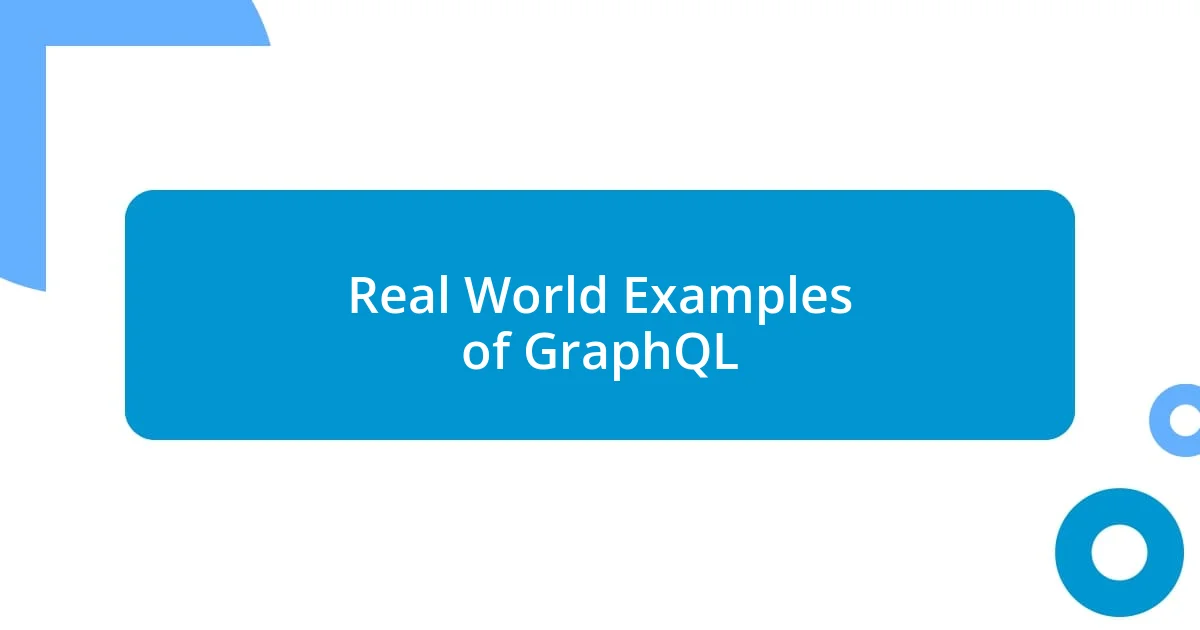
Real World Examples of GraphQL
When I think of real-world applications of GraphQL, one of the first examples that comes to mind is its use in Facebook. They developed GraphQL to address the unique challenges of their mobile applications, enabling developers to request exactly the data they need with a single query. I remember my initial reaction to that level of efficiency—imagine the possibilities! It resonated with me, revealing how adaptable GraphQL can be for large-scale data handling.
Another standout example is GitHub’s API. With GraphQL, they’ve created a more user-friendly experience for developers seeking to interact with their vast database of repositories. I felt inspired when I first tried it; the ability to navigate and pull exactly what I wanted with minimal overhead was liberating. Have you ever experienced that “aha” moment when technology just clicks? It’s a testament to how powerful a well-implemented GraphQL API can be in streamlining workflows.
Lastly, I’ve seen GraphQL make a noticeable impact on e-commerce platforms like Shopify. They provide a rich API that allows developers to customize storefronts effectively. After integrating GraphQL into a project for an online shop, it was impressive to witness how quickly we could iterate on features without the fear of breaking existing functionalities. Does that make you think about how efficient data fetching could transform your own projects? It certainly opened my eyes to the potential of GraphQL in creating dynamic, user-friendly experiences.
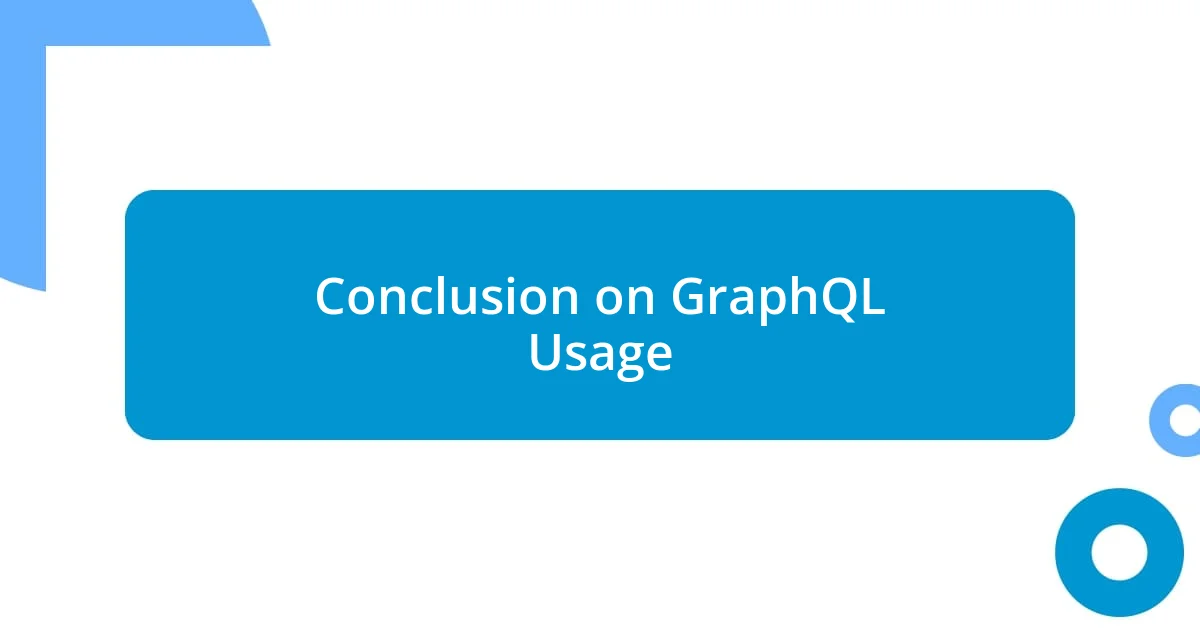
Conclusion on GraphQL Usage
Using GraphQL has transformed how I approach data-fetching challenges in my projects. I’ve often felt that rush of excitement when a single query solves multiple data requests, saving both time and resources. It’s like discovering a new shortcut that not only speeds things up but also clears away the clutter of unnecessary requests. Have you ever stumbled upon a tool that just seemed to click with your workflow? For me, GraphQL was that tool, making my development process smoother and more intuitive.
From my experience, adapting to GraphQL can be a learning curve, but it’s well worth the effort. I remember the initial confusion when transitioning from REST to GraphQL, but then I realized how much more control it gives developers over data retrieval. One particular project stands out; we managed to cut down our API calls dramatically, which not only improved performance but also simplified our codebase. Have you faced that moment when you’ve felt the weight of complexity lift? That’s what adopting GraphQL felt like—freeing and empowering.
Ultimately, the real value of GraphQL lies in its flexibility and ability to evolve with your project. I’ve witnessed firsthand how teams can innovate and iterate quickly when they aren’t bogged down by rigid API structures. Seeing a project rapidly take shape, without the constant friction of data management issues, has been truly exhilarating. Isn’t it fascinating how the right tools can catalyze creativity and progress? I believe that leveraging GraphQL has the potential to elevate our approaches to building modern applications.












